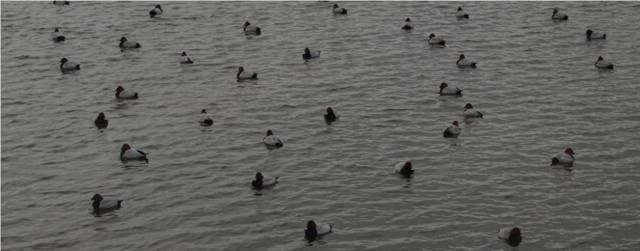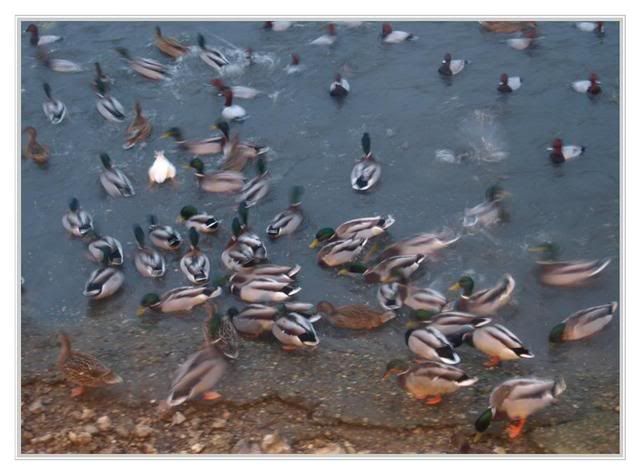One of the best places to see them is Welney, a Wildfowl and Wetlands Trust reserve on the Ouse Washes near Ely, so on a chilly, damp day in November ‘07, Mum and I headed down there to visit them; an afternoon feeding session guarantees a good turnout!
The Visitor Centre is new since the last time we were there – it’s very eco-friendly, with a reed-bed water-treatment system, and an excellent café.


Crossing the bridge, you reach the hide – well, I call it a hide, but it’s centrally heated and far more comfortable than any hide has a right to be. It looks out across the flooded Washes – watermeadows that take the brunt of the winter’s rainfall, and managed to provide an ideal habitat for the migrating wildfowl and for summer visitors in their turn. There are three types of swan here – mute swans, whoopers, and the smaller Bewick swans, although the latter don’t come in close, being kept off the grain feed by the other, bigger birds. (At the moment there is also a black swan, an escape from a local collection and rather unexpected!) As well as swans, there are any numbers of ducks. Most of the ones close-in are mallard (the usual village pond ducks) and pochard – these are the rather dapper grey and chestnut chaps.

Duck Fact: And they are nearly all chaps… the males leave the nesting grounds earlier than the females and young, and consequently take the northerly wintering sites, making the females go further south to Spain. (Hardship, girls!!) The males head back to the breeding grounds in Scandinavia at the start of the season, taking up territories ready for the arrival of the females who, of course, have further to come. The boys bustle around, jockeying for position to be in the right place when the warden comes with the grain barrow, prodding and pushing, diving down and popping up, often underneath an indignant swan, with a flurry of bubbles and a shuffle of feathers and a quick dash to avoid an indignant swan beak. The mallard don’t tend to dive, and have their females with them. They are more inclined to simply shove each other aside in the general melee.

As the light dims the swans start to arrive in greater numbers – up to 4,000 of them at the moment – and they start to parade back and forth in front of the hide, all competing for the right to be first at the food. Below us, the floodlights go on, and excitement builds amongst the birds. A sudden rush to the right alerts us to the warden with his barrow of grain; he makes his way along in front of us, casting scoops of grain into the water. All dignity amongst the swans is immediately lost, and the ducks become a feathered frenzy.

Twilight descends, and with it more swans, white shapes in the gloaming winging over our heads with a melodious and melancholy whooping song, slipping down the cold evening air onto the water, greeting each other with bobbing heads and touching beaks, small family groups – parents and this year’s ashy grey young – staying together amidst the growing flock. We stay until it is too dark to see any more, then take the road northwards, to home and bed.
Winter’s here.

5 comments:
Beautiful pix and prose! That sounds like a lovely site, even when they lose their serenity to feed.
I really wish your piece had sound with it, I'd love to hear the swans.
We get flocks of Canada geese flying over here and there is no more primal sound that to be socked in with fog but hear them calling above as they pass.
Jude
Mad, such a beautifully written piece :-) not to mention the photos :manic:
i will never tire of reading your tales about nature in all its forms; you have a rare talent.
:smooch:
Mad - lovely, lovely photos...found myself thinking some of them would make great wrapping paper. I really enjoy your blog!
I didn't know they did centrally heated hides - what luxury! The ducks vs. indignant swans - who needs telly? Nice to see you making such good use of the new camera.
Adorable photos and really great comments, Mad! I learned something new again, never knew what the grey-chestnut coloured ducks were called. Apparently in German it's Tafelente (pochard).
Post a Comment